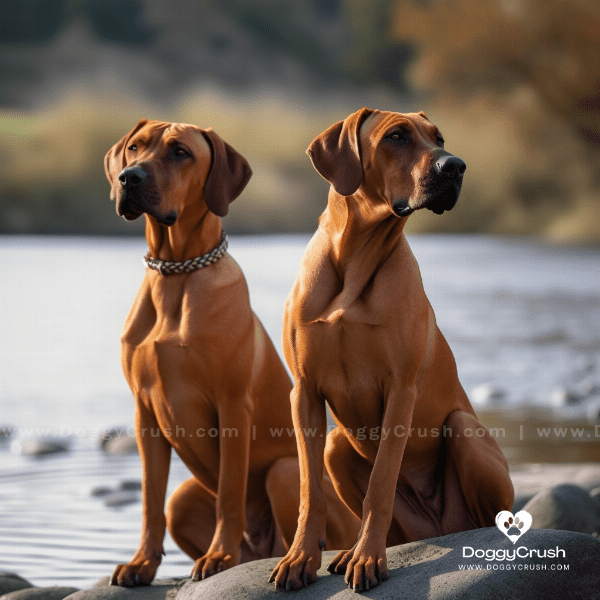Table of Contents
- Introduction to Greyhound Dogs
- History and Origin of Greyhound Dogs
- Physical Characteristics of Greyhound Dogs
- Temperament and Personality of Greyhound Dogs
- Health and Care for Greyhound Dogs
- Training and Exercise for Greyhound Dogs
- Feeding and Nutrition for Greyhound Dogs
- Living with Greyhound Dogs: Tips and Advice
- Greyhound Dog Sports and Activities
- Adopting a Greyhound Dog: What You Need to Know.
Introduction to Greyhound Dogs
Greyhound dogs are a breed of sighthounds that have been around for thousands of years. These dogs are known for their incredible speed and agility, and they have a long history of being used for hunting and racing. In this section, we will explore the fascinating world of greyhound dogs, including their history, physical characteristics, and temperament.
A Brief History of Greyhound Dogs
The exact origin of greyhound dogs is unclear, but they are believed to have been around since ancient times. They were originally bred for hunting, and their speed and agility made them highly effective at chasing down prey. Over time, they became popular as racing dogs, and today, they are one of the most beloved breeds in the world.
Physical Characteristics of Greyhound Dogs
Greyhound dogs are a large breed, typically weighing between 60 and 80 pounds. They have a long, slender body and powerful legs that allow them to run at incredible speeds. They also have a distinctive narrow head, pointed ears, and sharp eyesight that make them well-suited for hunting and racing.
Temperament and Personality of Greyhound Dogs
Despite their reputation as racing dogs, greyhounds are known for their gentle and affectionate nature. They are loyal and devoted to their owners and are typically very good with children and other pets. Greyhounds are also intelligent and can be trained to perform a variety of tasks, including obedience training and agility competitions.
Overall, greyhound dogs are a unique and fascinating breed that have captured the hearts of dog lovers around the world. In the following sections, we will delve deeper into the history, physical characteristics, temperament, and care of these magnificent animals.

History and Origin of Greyhound Dogs
The history of greyhound dogs can be traced back to ancient Egypt, where they were revered as sacred animals and were often depicted in artwork and hieroglyphics. From there, the breed spread throughout the Mediterranean region and eventually made its way to Europe, where it became popular for hunting.
Greyhounds in Hunting
Greyhounds were highly prized for their speed and agility, and they were often used to hunt game such as rabbits, foxes, and deer. In medieval times, they were a favorite of nobles and royalty, who would often hold hunting parties where greyhounds were used to chase down prey.
Greyhounds in Racing
By the 19th century, greyhound racing had become a popular sport in England, and the first modern greyhound race was held in Hendon, London in 1876. The sport quickly spread throughout Europe and eventually made its way to the United States, where it remains popular to this day.
Greyhounds as Pets
Despite their long history as working and racing dogs, greyhounds are also highly prized as pets. They are known for their calm and gentle nature, and they make excellent companions for families and individuals alike.
Greyhounds and Rescue
Unfortunately, greyhounds are also a breed that has been subjected to mistreatment and neglect. Many racing greyhounds are abandoned or euthanized once they are no longer useful for racing, and there are a number of organizations dedicated to rescuing and rehoming these dogs.
Overall, the history and origin of greyhound dogs is a fascinating and complex topic. From their origins in ancient Egypt to their modern-day role as beloved pets and racing dogs, greyhounds have played an important role in human history and culture.

Physical Characteristics of Greyhound Dogs
Greyhound dogs are known for their distinctive appearance and impressive physical abilities. In this section, we will explore the various physical characteristics that make greyhounds unique.
Size and Weight
Greyhounds are a large breed of dog, typically weighing between 60 and 80 pounds. They are also tall, with males standing between 26 and 30 inches at the shoulder and females standing between 24 and 28 inches.
Coat and Color
Greyhound dogs have a short, smooth coat that comes in a variety of colors, including black, fawn, brindle, and white. Some greyhounds also have markings such as spots or patches.
Body Structure
Greyhound dogs have a unique body structure that is built for speed and agility. They have a long, slender body with a deep chest and a narrow waist. Their legs are long and powerful, and they have large, padded feet that help them grip the ground as they run.
Senses
Greyhound dogs have highly developed senses, including keen eyesight and excellent hearing. They are able to spot prey from a great distance and can track it by scent as well.
Lifespan
The average lifespan of a greyhound dog is between 10 and 14 years. With proper care and attention, some greyhounds have been known to live into their late teens.
Overall, greyhound dogs are a unique and fascinating breed that possess a variety of physical characteristics that make them well-suited for their various roles, from hunting to racing to companionship.
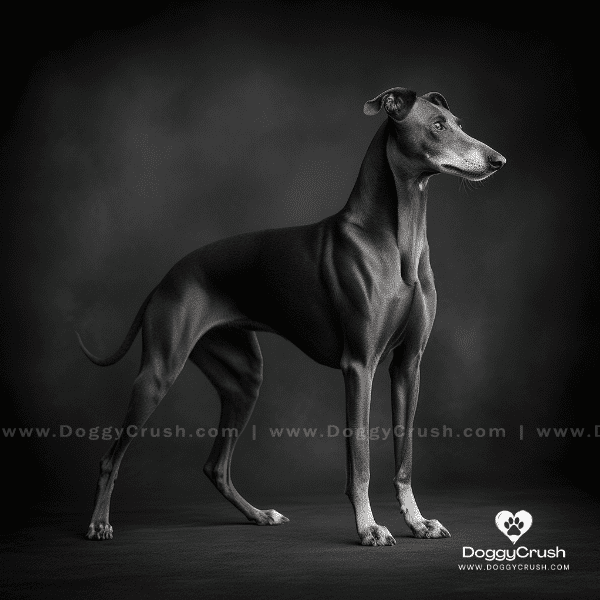
Temperament and Personality of Greyhound Dogs
Greyhound dogs are known for their gentle and affectionate nature, and they make excellent companions for families and individuals alike. In this section, we will explore the various aspects of greyhound temperament and personality.
Intelligence
Greyhounds are intelligent dogs that are quick to learn new things. They are able to adapt to a variety of environments and can be trained to perform a range of tasks, from basic obedience to more advanced tasks such as agility competitions.
Gentle and Calm
One of the most notable aspects of greyhound temperament is their gentle and calm nature. They are typically very patient with children and other pets, and they are not prone to aggression or destructive behavior.
Reserved with Strangers
While greyhounds are generally very friendly and affectionate with their owners, they can be somewhat reserved with strangers. This is due in part to their history as hunting and racing dogs, which has made them naturally cautious around new people.
Independent
Greyhounds are known for their independence and self-reliance. While they enjoy spending time with their owners, they are also content to spend time alone and are not prone to separation anxiety or destructive behavior when left alone.
Affectionate
Despite their independence, greyhounds are also very affectionate dogs that enjoy being close to their owners. They are often described as “velcro dogs” due to their tendency to follow their owners around the house and always be by their side.
Overall, the temperament and personality of greyhound dogs is one of their most endearing qualities. They are gentle, intelligent, and affectionate dogs that make excellent companions for a wide range of people and lifestyles.
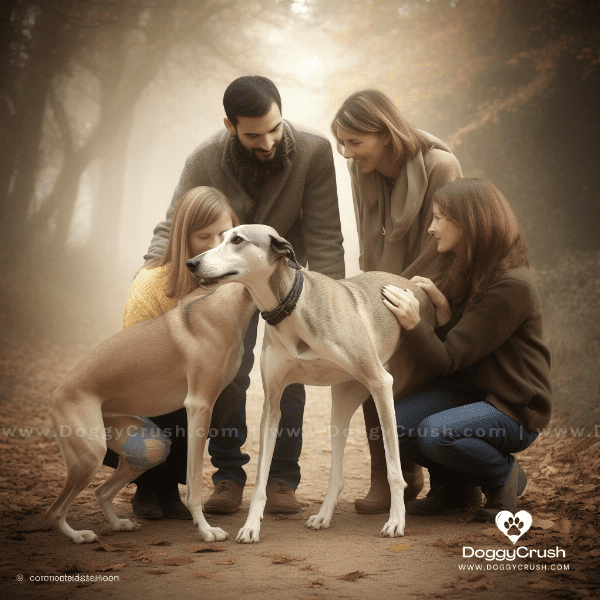
Health and Care for Greyhound Dogs
Greyhound dogs are generally healthy and resilient animals, but they do require proper care and attention to ensure they remain in good health. In this section, we will explore the various aspects of greyhound health and care.
Common Health Issues
Like all breeds of dogs, greyhounds are susceptible to a variety of health issues. Some of the most common health issues seen in greyhounds include hip dysplasia, heart disease, and eye problems. It is important to work with a veterinarian who is familiar with greyhound health issues in order to provide the best possible care.
Nutrition
Proper nutrition is essential for keeping greyhounds healthy and happy. Greyhounds have unique nutritional needs, and it is important to feed them a high-quality diet that is formulated for their breed. It is also important to monitor their weight, as greyhounds are prone to obesity.
Preventive Care
Preventive care is essential for keeping greyhounds healthy. This includes regular veterinary checkups, vaccinations, and parasite prevention. It is also important to provide a safe and comfortable living environment for your greyhound, with plenty of opportunities for exercise, socialization, and mental stimulation.
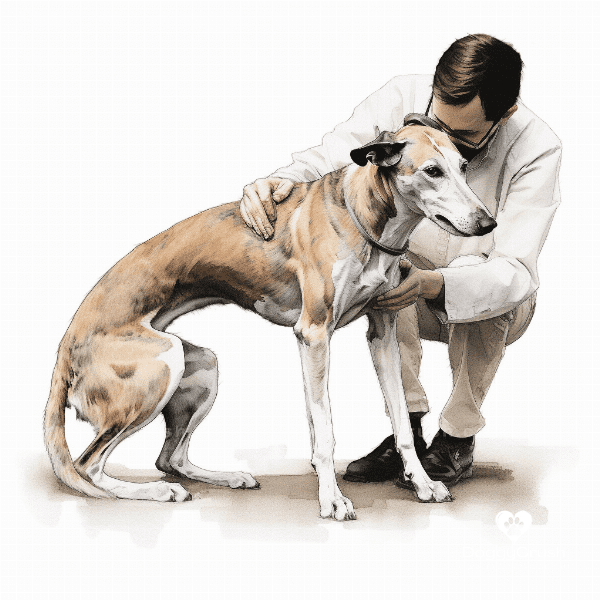
Training and Exercise for Greyhound Dogs
Exercise Requirements
Greyhounds are athletic dogs that require regular exercise to stay healthy and happy. They enjoy running and playing, and they need plenty of space to do so. Greyhounds are particularly well-suited for activities such as lure coursing, which allows them to use their natural instincts and abilities.
Training
Greyhounds are intelligent dogs that are quick to learn new things. They can be trained to perform a wide range of tasks, from basic obedience to more advanced activities such as agility competitions. Positive reinforcement training methods are typically most effective with greyhounds, as they respond well to praise and rewards.
Socialization
Socialization is an important aspect of greyhound training. Greyhounds can be somewhat reserved with strangers, so it is important to expose them to a variety of people and situations from an early age. This can help to prevent shyness and anxiety later on.
Mental Stimulation
In addition to physical exercise, greyhounds also require mental stimulation to stay healthy and happy. This can include activities such as puzzle toys, scent games, and obedience training. Providing plenty of mental stimulation can help prevent boredom and destructive behavior.
Consistency
Consistency is key when it comes to greyhound training and exercise. Regular exercise and training sessions can help to reinforce good behavior and prevent bad habits from forming. Consistency also helps to build a strong bond between you and your greyhound.
Overall, training and exercise are essential for keeping greyhound dogs healthy and happy. By providing plenty of exercise, training, socialization, and mental stimulation, you can help ensure that your greyhound remains active, happy, and well-behaved.
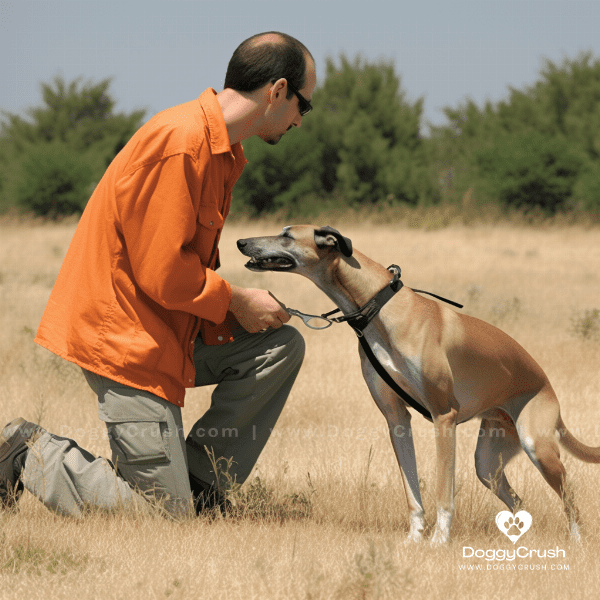
Feeding and Nutrition for Greyhound Dogs
Proper nutrition is essential for keeping greyhound dogs healthy and happy. In this section, we will explore the various aspects of greyhound feeding and nutrition.
Nutritional Needs
Greyhounds have unique nutritional needs that must be met in order to maintain their health and well-being. They require a high-quality diet that is rich in protein and essential nutrients, such as vitamins and minerals. Greyhounds also require a high-calorie diet, as they have a fast metabolism and burn calories quickly.
Feeding Schedule
Greyhounds should be fed on a regular schedule to maintain their health and prevent obesity. It is recommended that they be fed twice a day, with a total of 2-4 cups of food per day, depending on their size, age, and activity level. It is also important to provide access to fresh water at all times.
Choosing the Right Food
Choosing the right food for your greyhound can be a challenge, as there are many options available. It is important to choose a high-quality dog food that is specifically formulated for their breed and age. Look for a food that contains high-quality protein sources, such as chicken, beef, or fish, as well as essential nutrients such as vitamins and minerals.
Avoiding Obesity
Greyhounds are prone to obesity, which can lead to a variety of health issues. It is important to monitor your greyhound’s weight and adjust their diet and exercise routine as necessary. Avoid feeding your greyhound table scraps or treats that are high in fat or calories.
Supplements
Supplements can be beneficial for greyhound dogs, particularly those that are older or have specific health concerns. Speak with your veterinarian to determine if your greyhound could benefit from supplements such as glucosamine or omega-3 fatty acids.
Overall, feeding and nutrition are essential for keeping greyhound dogs healthy and happy. By choosing the right food, feeding on a regular schedule, and monitoring your greyhound’s weight and health, you can help ensure that they remain healthy and active for years to come.
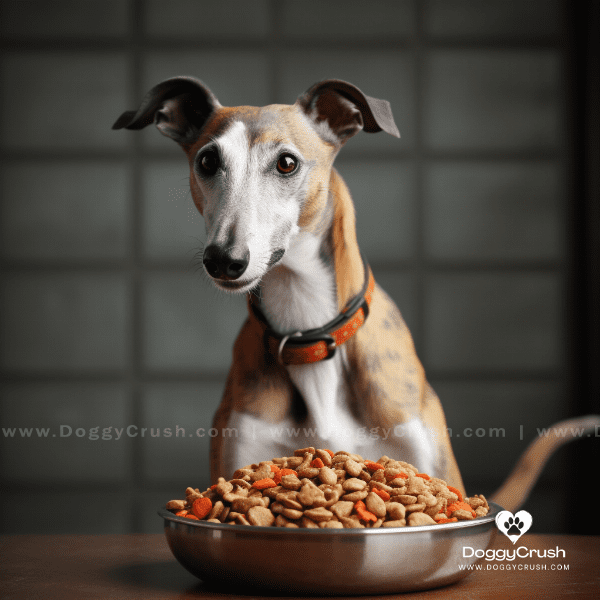
Living with Greyhound Dogs: Tips and Advice
Greyhound dogs make excellent companions, but there are some things to keep in mind when living with these unique and fascinating animals. In this section, we will explore some tips and advice for living with greyhound dogs.
Providing Plenty of Exercise
Greyhounds are athletic dogs that require plenty of exercise to stay healthy and happy. It is important to provide them with ample opportunities to run and play, whether it is in a fenced-in yard, a dog park, or through activities such as lure coursing. Without enough exercise, greyhounds can become restless and destructive.
Keeping Greyhounds Safe
Greyhounds have a strong prey drive, and they may be tempted to chase small animals such as squirrels or rabbits. It is important to keep them on a leash or in a secure fenced-in area when outside to prevent them from running off or getting into trouble. Greyhounds also have thin skin and may be prone to injury, so it is important to take care when handling them.
Grooming and Maintenance
Greyhounds have short, smooth coats that require minimal grooming. They do shed, however, so regular brushing is recommended to keep their coat looking shiny and healthy. Greyhounds also require regular nail trims and dental care.
Providing Plenty of Love and Affection
Greyhounds are known for their gentle and affectionate nature, and they thrive on attention and love from their owners. It is important to provide plenty of love and affection to your greyhound, whether it is through playtime, cuddles, or simply spending time together.
Overall, living with a greyhound dog can be a rewarding and enriching experience. By providing plenty of exercise, preparing for separation anxiety, keeping them safe, providing grooming and maintenance, and showing them plenty of love and affection, you can help ensure that your greyhound remains healthy and happy for years to come.
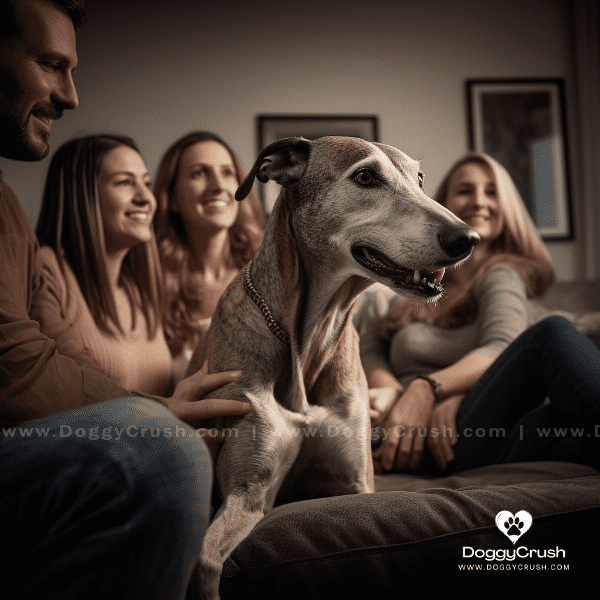
Greyhound Dog Sports and Activities
Greyhounds are athletic dogs that excel in a variety of sports and activities. In this section, we will explore some of the most popular sports and activities for greyhound dogs.
Lure Coursing
Lure coursing is a popular activity for greyhound dogs that allows them to use their natural instincts and abilities. In lure coursing, dogs chase a mechanical lure around a course, simulating the experience of chasing prey. Lure coursing can be a great way to provide exercise and mental stimulation for greyhounds.
Agility
Agility is a fast-paced and exciting sport that involves dogs navigating through an obstacle course. Greyhounds are known for their speed and agility, making them excellent competitors in agility competitions. Agility can be a great way to provide exercise and mental stimulation for greyhounds.
Obedience Training
Obedience training is a great way to teach your greyhound basic commands and improve their behavior. Greyhounds are intelligent dogs that are quick to learn, making them well-suited for obedience training. Obedience training can also help to build a stronger bond between you and your greyhound.
Therapy Work
Greyhounds have a gentle and affectionate nature that makes them well-suited for therapy work. Therapy dogs provide comfort and emotional support to people in hospitals, nursing homes, and other settings. Greyhounds are particularly well-suited for therapy work due to their calm and gentle demeanor.
Racing
While racing is not as common as it once was, greyhounds are still used for racing in some parts of the world. Racing can be a controversial sport, however, due to concerns about animal welfare. It is important to research any racing facilities carefully and ensure that they prioritize the health and well-being of their dogs.
Overall, greyhound dogs are well-suited for a variety of sports and activities. By participating in activities such as lure coursing, agility, obedience training, therapy work, or even racing, you can provide exercise, mental stimulation, and enrichment for your greyhound.
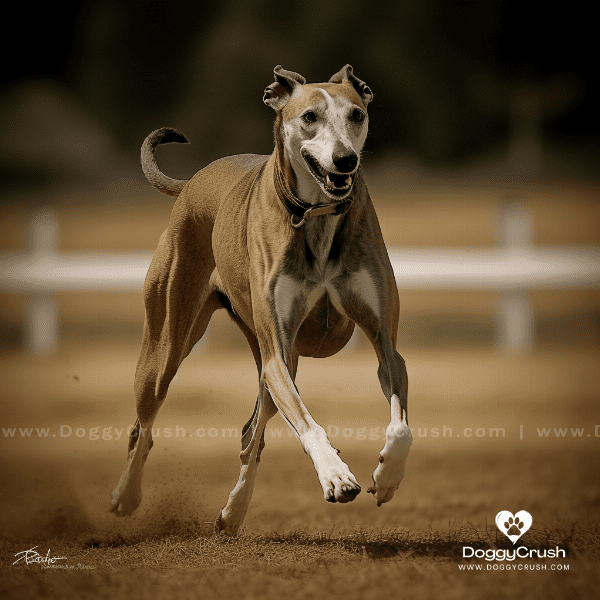
Adopting a Greyhound Dog: What You Need to Know.
Adopting a greyhound dog can be a wonderful and rewarding experience, but it is important to be prepared for the unique needs of this breed. In this section, we will explore what you need to know before adopting a greyhound dog.
Finding a Reputable Rescue or Adoption Group
There are many rescue and adoption groups that specialize in greyhound dogs. It is important to research and find a reputable group that prioritizes the health and well-being of their dogs. These groups can provide valuable information and support throughout the adoption process.
Understanding Greyhound Personality and Temperament
Greyhounds have a unique personality and temperament that may differ from other breeds of dogs. They are known for their gentle and affectionate nature, but they can also be somewhat reserved or independent. It is important to understand and be prepared for the unique characteristics of the breed.
Providing Proper Exercise and Socialization
Greyhounds are athletic dogs that require plenty of exercise to stay healthy and happy. They also benefit from regular socialization with people and other animals. It is important to provide ample opportunities for exercise and socialization in order to prevent boredom and anxiety.
Proper Nutrition and Grooming
Proper nutrition and grooming are essential for keeping greyhound dogs healthy and happy. Greyhounds have unique nutritional needs that must be met in order to maintain their health and well-being. They also have short, smooth coats that require minimal grooming, but they do require regular nail trims and dental care.
Preparing for Separation Anxiety
Greyhounds can be prone to separation anxiety, which can lead to destructive behavior or other issues. It is important to gradually acclimate your greyhound to being alone and to provide plenty of mental stimulation and toys to keep them occupied when you are away.
Adjusting to Life with a Greyhound
Adjusting to life with a greyhound can take time and patience. It is important to provide a safe and comfortable living environment for your greyhound, with plenty of opportunities for exercise, socialization, and mental stimulation. By being patient and understanding, you can help your greyhound adjust to their new home and become a beloved member of your family.
Overall, adopting a greyhound dog can be a wonderful and enriching experience. By finding a reputable adoption group, understanding the breed’s personality and temperament, providing proper exercise and socialization, and preparing for separation anxiety, you can help ensure that your greyhound is happy, healthy, and well-adjusted in their new home.


